When it comes to Tonkotsu Ramen, Hakata Ramen comes to mind. The origin is said to be in Kurume, which is a widely accepted theory. There are also perspectives that distinguish between Nagahama Ramen and Hakata Ramen. In the past, its smell was avoided, and it wasn't so popular in the Kanto region, but recently, with the expansion of major chain stores and frequent features on TV and magazines, it is becoming nationwide.
I decided to make such Hakata-style Tonkotsu Ramen at home. First, I prepare the pork bones. You can get them cheaply if you ask a butcher, but this time I ordered them on Rakuten. They arrived a few days after the order. It's convenient. The quality is much better than I thought.
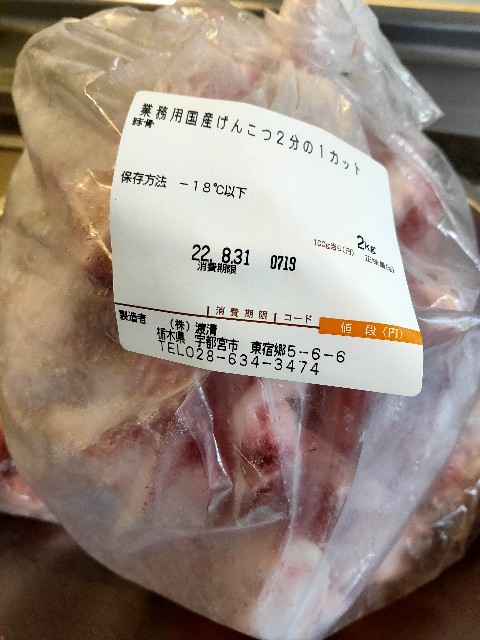
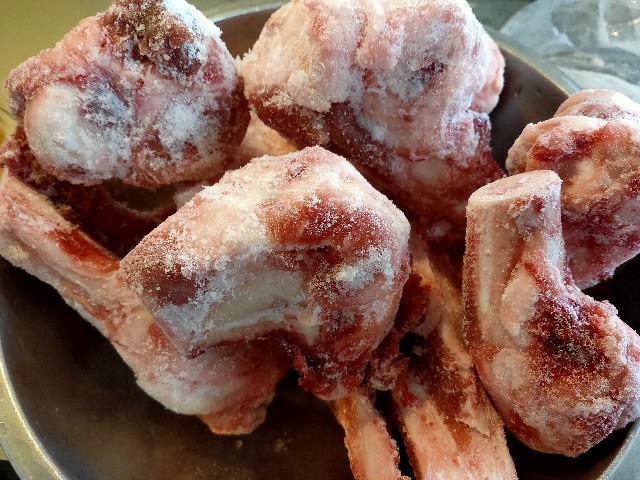
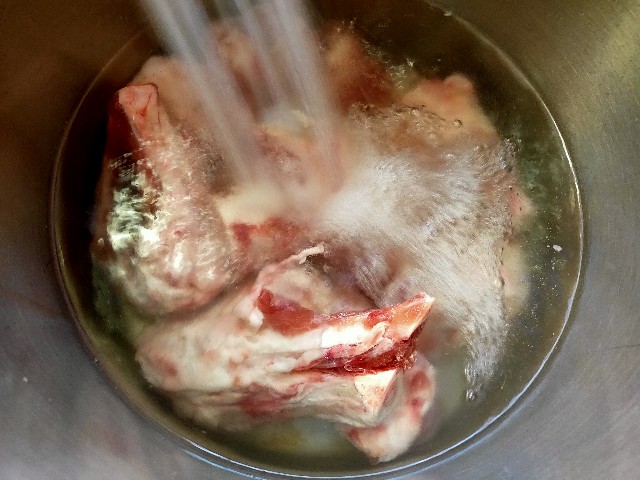
Wash them well with water to remove blood and dirt.
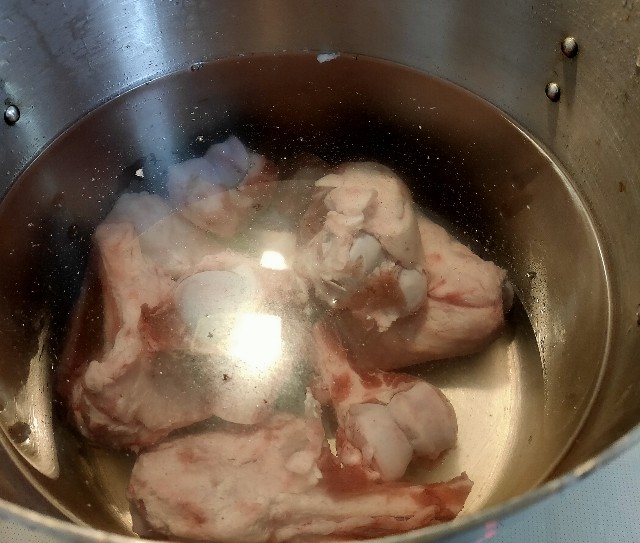
Put them in a pot, and boil them on high heat for about an hour to remove the scum.
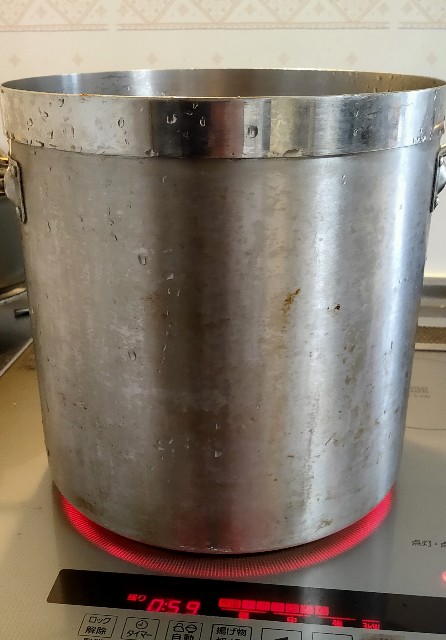
After about an hour, wash them well under running water. This is the most troublesome part of making ramen. It's good to use a brand-new scrubbing brush. After washing, put them back in the pot, add a lot of water, and boil it vigorously on high heat. If the water decreases, add more to keep about 70% of the pot's volume.
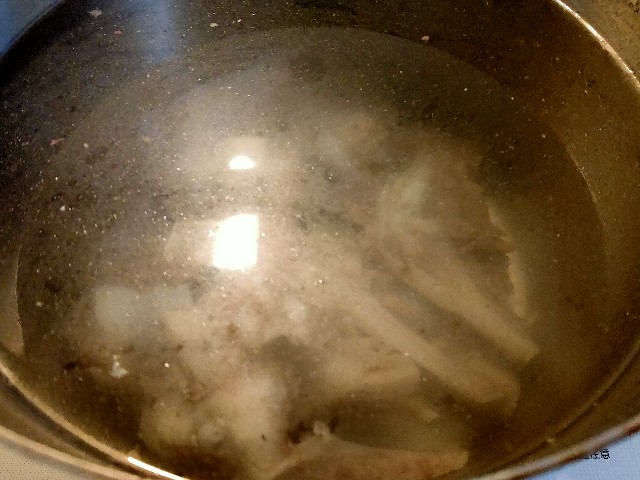
You will probably end up boiling it for about 8 to 10 hours.
To be continued...
Click the link below to view the Japanese version of the article
【一蘭直販限定商品】一蘭 ラーメン 博多細麺(ストレート) 秘伝の粉付 5食入×2個10食セット
博多ラーメン (Hakata Ramen): This is a type of ramen from Hakata, a ward in Fukuoka city in Japan. It is characterized by its rich, milky, pork-bone tonkotsu broth and thin, non-curly noodles.
とんこつラーメン (Tonkotsu Ramen): Tonkotsu ramen is a ramen dish that originated in Fukuoka, Fukuoka Prefecture on the Kyushu island of Japan, and it is a specialty dish in both Fukuoka and Kyushu. The soup broth is based on pork bones and other ingredients, which are typically boiled for several hours, and the dish is traditionally served with ramen noodles that are hard in the center and topped with sliced pork belly.
源流 (Genryu): This term means "origin" or "source". In this context, it refers to the origin of Hakata Ramen.
久留米 (Kurume): Kurume is a city located in Fukuoka Prefecture, Japan. It is said to be the origin of Hakata Ramen.
長浜ラーメン (Nagahama Ramen): Nagahama Ramen is another type of ramen from Fukuoka, known for its tonkotsu broth like Hakata Ramen. Some people distinguish between the two, but they are quite similar.
関東 (Kanto): The Kanto region is a geographical area of Japan, consisting of seven prefectures: Gunma, Tochigi, Ibaraki, Saitama, Tokyo, Chiba, and Kanagawa. In the past, Tonkotsu Ramen was not so popular in this region.
チェーン店 (Chain store): This term refers to retail outlets that share a brand and central management, often having standardized business methods and practices. In this context, it refers to ramen restaurant chains.
豚骨 (Pork bones): These are the bones of a pig. They are used to make the broth for Tonkotsu Ramen.
肉屋さん (Butcher): A butcher is a person who may slaughter animals, dress their flesh, sell their meat, or participate within any combination of these three tasks. In this context, it refers to a place where you can buy pork bones.
楽天 (Rakuten): Rakuten, Inc. is a Japanese electronic commerce and online retailing company based in Tokyo. In this context, it refers to the platform where the author ordered pork bones.
水 (Water): A transparent, tasteless, odorless, and nearly colorless chemical substance, which is the main constituent of Earth's streams, lakes, and oceans, and the fluids of most living organisms. It's used here for washing and boiling the pork bones.
血 (Blood): The red liquid that circulates in the arteries and veins of humans and other vertebrate animals, carrying oxygen to and carbon dioxide from the tissues of the body. In this context, it refers to the blood on the pork bones that needs to be washed off.
汚れ (Dirt): Any substance that makes an object unclean or impure. In this context, it refers to the impurities on the pork bones that need to be washed off.
寸胴 (Pot): A pot is a type of cookware used for cooking. The term "寸胴" refers to a type of pot that is deep and cylindrical, often used for boiling or stewing.
アク抜き (Scum removal): The process of boiling meat or fish to remove the scum or impurities. It's an important step in making clear soup or broth.
流水 (Running water): Water supplied to a household, business, or community from a central source, typically via a system of pipes. In this context, it refers to the water from the tap used to wash the boiled pork bones.
**亀の子たわし (Turtle scrubber)**: A type of scrubbing brush in Japan, often used for washing dishes or cleaning. The term "亀の子" literally means "turtle's child", referring to its shape resembling a small turtle.
水をたくさん入れて (Add a lot of water): This phrase refers to the step of adding a large amount of water to the pot for boiling the pork bones.
強火 (High heat): This term refers to the high setting on a stove or burner, used for boiling or cooking food quickly.
ぐつぐつと煮る (Boil vigorously): This phrase describes the action of boiling something vigorously or at a rolling boil. It's used here to describe the process of cooking the pork bones to make the broth.
水が減ったら追加していき (Add more if the water decreases): This phrase instructs to replenish the water in the pot as it evaporates during the boiling process.
寸胴の7割くらいの量をキープする (Keep about 70% of the pot's volume): This phrase instructs to maintain the water level in the pot at about 70% of its total volume during the boiling process.
おおよそ8時間~10時間くらい煮ることになるだろう (You will probably end up boiling it for about 8 to 10 hours): This phrase estimates the duration of the boiling process to extract the flavors from the pork bones into the broth.
自作 (Homemade): This term refers to something that is made at home, rather than bought from a store or restaurant. In this context, it refers to the process of making Tonkotsu Ramen at home.
有力 (Influential/Leading): This term means "influential" or "leading". In this context, it refers to the major chain stores that have contributed to the popularity of Tonkotsu Ramen.
テレビ (TV): Short for "television", it refers to a system for transmitting visual images and sound that are reproduced on screens. In this context, it refers to the medium through which Tonkotsu Ramen has been featured and popularized.
雑誌 (Magazine): A periodical publication containing articles and illustrations, typically covering a particular subject or area of interest. In this context, it refers to the medium through which Tonkotsu Ramen has been featured and popularized.
全国区 (Nationwide): This term refers to something that is spread or recognized all over the country. In this context, it refers to the widespread popularity of Tonkotsu Ramen.
注文 (Order): This term refers to the act of requesting some product or service. In this context, it refers to the act of ordering pork bones online.
到着 (Arrival): This term refers to the act of reaching a place at the end of a journey or a stage in a journey. In this context, it refers to the delivery of the ordered pork bones.
単語解説
Let's - 動詞 - 「~しましょう」という意味を表す表現。話し手が聞き手に対して一緒に何かをすることを提案するときに使います。
make - 動詞 - 「作る」、「製造する」などの意味を持つ単語。物や食事を作ることから、計画やアイデアを形にすることまで幅広く使われます。
Hakata-style - 形容詞 - 「博多風」を意味する表現。博多は日本の福岡県にある地域で、特定の料理や製品が博多地域特有のスタイルや特徴を持つことを示します。
Tonkotsu - 名詞 - 「とんこつ」を意味する単語。豚骨を主成分としたスープで、特にラーメンのスープとして知られています。
Ramen - 名詞 - 「ラーメン」を意味する単語。中華麺をベースにした日本の人気料理で、多種多様なトッピングとスープで提供されます。
at - 前置詞 - 「~で」、「~に」などの意味を持つ単語。場所や時間を示す際に使われます。
home - 名詞 - 「家」を意味する単語。自分の住居や居住地を指す一般的な表現です。
Speaking - 動詞 - 「話す」、「述べる」などの意味を持つ単語。一般的には人間が言葉を使って情報を伝える行為を指します。
Tonkotsu - 名詞 - 「とんこつ」を意味する単語。豚骨を主成分としたスープで、特にラーメンのスープとして知られています。
Ramen - 名詞 - 「ラーメン」を意味する単語。中華麺をベースにした日本の人気料理で、多種多様なトッピングとスープで提供されます。
Hakata - 名詞 - 「博多」を意味する単語。福岡県の一部で、とんこつラーメンで有名です。
Ramen - 名詞 - 「ラーメン」を意味する単語。中華麺をベースにした日本の人気料理で、多種多様なトッピングとスープで提供されます。
theory - 名詞 - 「理論」、「説」などの意味を持つ単語。一般的には、事実や現象を説明するための考え方や原則を指します。
originates - 動詞 - 「起源を持つ」、「始まる」などの意味を持つ単語。何かが始まった場所や時間、またはその起源や根源を指す際に使われます。
Kurume - 名詞 - 「久留米」を意味する単語。福岡県にある都市で、とんこつラーメンの発祥地とされています。
considered - 動詞 - 「考えられる」、「見なされる」などの意味を持つ単語。一般的には、何かを特定の方法で評価または解釈することを指します。
powerful - 形容詞 - 「有力な」、「強力な」などの意味を持つ単語。何かが他のものよりも影響力がある、または効果的であることを示します。
Nagahama - 名詞 - 「長浜」を意味する単語。福岡県福岡市の一部で、博多ラーメンとは異なるスタイルのラーメンが特徴です。
distinguish - 動詞 - 「区別する」を意味する単語。二つ以上のものを識別するために使われます。
thinking - 名詞 - 「考え方」を意味する単語。特定の視点や観点から物事を理解し、解釈する方法を指します。
previously - 副詞 - 「以前は」を意味する単語。過去のある時点を指すために使われます。
odor - 名詞 - 「臭い」を意味する単語。感覚的な経験で、特に鼻を通じて感じるものを指します。
avoided - 動詞 - 「避ける」を意味する単語。何かを故意に避ける、または避ける行為を指します。
Kanto - 名詞 - 「関東」を意味する単語。日本の地域の一つで、東京都や神奈川県などを含みます。
major - 形容詞 - 「メジャーな」、「主要な」を意味する単語。何かが広く認識されている、または重要な地位を持っていることを示します。
recently - 副詞 - 「最近」を意味する単語。過去の短い期間を指すために使われます。
powerful - 形容詞 - 「有力な」、「強力な」などの意味を持つ単語。何かが他のものよりも影響力がある、または効果的であることを示します。
chain store - 名詞 - 「チェーン店」を意味する単語。同じブランド名や商標を持つ複数の店舗のことを指します。
expansion - 名詞 - 「展開」を意味する単語。何かが広がる、または大きくなるプロセスを指します。
television - 名詞 - 「テレビ」を意味する単語。映像と音声を送受信する電子機器を指します。
magazines - 名詞 - 「雑誌」を意味する単語。定期的に発行され、特定のトピックや一般的な興味に関する記事を提供する出版物を指します。
actively - 副詞 - 「積極的に」を意味する単語。何かを積極的に、または意欲的に行うことを示します。
featured - 動詞 - 「取り上げられる」を意味する単語。何かが特別に強調されたり、注目されたりすることを指します。
nationwide - 形容詞 - 「全国的な」を意味する単語。ある国全体をカバーする、または影響を及ぼすことを示します。
becoming - 動詞 - 「〜になる」を意味する単語。ある状態や状況に変化することを示します。
decided - 動詞 - 「決める」を意味する単語。特定の行動をとるか、または特定の結果を達成するための選択をすることを指します。
prepare - 動詞 - 「準備する」を意味する単語。何かを行うための準備や計画をすることを示します。
pork bones - 名詞 - 「豚骨」を意味する単語。豚の骨を指し、特にラーメンのスープのベースとして使用されます。
butcher - 名詞 - 「肉屋」を意味する単語。肉や鳥を販売する人や店を指します。
request - 動詞 - 「依頼する」を意味する単語。他の人に何かをするように頼む行為を指します。
cheaply - 副詞 - 「安く」を意味する単語。低いコストで何かを得ることを示します。
obtain - 動詞 - 「手に入れる」を意味する単語。何かを手に入れること、または取得することを指します。
ordered - 動詞 - 「注文する」を意味する単語。商品やサービスを購入するためにリクエストを送ることを指します。
convenient - 形容詞 - 「便利な」を意味する単語。何かが使いやすく、または問題なく行えることを示します。
quality - 名詞 - 「品質」を意味する単語。商品やサービスの優れた特性や特徴を指します。
expected - 動詞 - 「期待する」を意味する単語。特定の結果や行動を予想または予測することを指します。
wash - 動詞 - 「洗う」を意味する単語。水や他の液体を使って何かを清潔にする行為を指します。
blood - 名詞 - 「血」を意味する単語。体内を循環し、酸素や栄養を運ぶ液体を指します。
dirt - 名詞 - 「汚れ」を意味する単語。清潔でない状態や物質を指します。
remove - 動詞 - 「取り除く」を意味する単語。何かをその場所や位置から移動させることを指します。
pot - 名詞 - 「鍋」を意味する単語。料理をするための容器を指します。
boil - 動詞 - 「煮る」を意味する単語。液体を高温に加熱して気化させる行為を指します。
hour - 名詞 - 「時間」を意味する単語。時間の単位で、60分を指します。
rinse - 動詞 - 「すすぐ」を意味する単語。水や他の液体で何かを洗い流す行為を指します。
work - 名詞 - 「作業」を意味する単語。特定の目的を達成するための活動や努力を指します。
troublesome - 形容詞 - 「面倒な」を意味する単語。困難や問題を引き起こす可能性のある何かを指します。
new - 形容詞 - 「新しい」を意味する単語。最近作られた、またはまだ使用されていない何かを指します。
scrub - 動詞 - 「こする」を意味する単語。固いブラシやスポンジを使って表面を強くこすり洗う行為を指します。
good - 形容詞 - 「良い」を意味する単語。質が高い、または期待に合致している何かを指します。
finish - 動詞 - 「終える」を意味する単語。何かを完全に終わらせる行為を指します。
again - 副詞 - 「再び」を意味する単語。以前に行われた行為がもう一度行われることを指します。
add - 動詞 - 「追加する」を意味する単語。すでに存在する何かに何かを加える行為を指します。
keep - 動詞 - 「保つ」を意味する単語。特定の状態や位置を維持する行為を指します。
quantity - 名詞 - 「量」を意味する単語。物事の大きさ、数、程度を指します。
about - 前置詞 - 「約」を意味する単語。大体の数値や時間を示すときに使います。
boil - 動詞 - 「煮る」を意味する単語。液体を高温に加熱して気化させる行為を指します。
will - 助動詞 - 「~するだろう」を意味する単語。未来の出来事や意図を表すのに使います。
probably - 副詞 - 「おそらく」を意味する単語。何かが起こる可能性が高いことを示すのに使います。
hour - 名詞 - 「時間」を意味する単語。時間の単位で、60分を指します。
become - 動詞 - 「~になる」を意味する単語。ある状態から別の状態に変化することを示します。
end - 名詞 - 「終わり」を意味する単語。何かが終了する点や場所を指します。
up - 前置詞 - 「上に」を意味する単語。位置や方向を示すのに使います。
with - 前置詞 - 「~と」という意味の単語。人や物と一緒にいることや、道具を使って何かをすることを示します。
this - 代名詞 - 「これ」を意味する単語。話し手が指している特定の物事を指します。
way - 名詞 - 「方法」を意味する単語。何かを達成するための手段や進行方向を指します。
you - 代名詞 - 「あなた」を意味する単語。話し手が話している相手を指します。
can - 助動詞 - 「~することができる」を意味する単語。能力や可能性を表すのに使います。
create - 動詞 - 「作る」を意味する単語。何か新しいものを生み出す行為を指します。
your - 所有格代名詞 - 「あなたの」を意味する単語。話し手が話している相手の所有物を指します。
own - 形容詞 - 「自分自身の」を意味する単語。個人の所有や独自性を強調するのに使います。
version - 名詞 - 「バージョン」または「種類」を意味する単語。何かの異なる形や型を指します。
delicious - 形容詞 - 「美味しい」を意味する単語。食べ物や飲み物が非常に良い味がすることを表します。
Hakata-style - 形容詞 - 「博多風の」を意味する単語。博多地域の特徴を持つものを指します。
Tonkotsu - 名詞 - 「とんこつ」を意味する単語。豚骨を主成分としたスープや料理を指します。
Ramen - 名詞 - 「ラーメン」を意味する単語。中華風の麺料理を指します。
First - 副詞 - 「最初に」を意味する単語。何かの順序やシーケンスの最初の部分を指します。
prepare - 動詞 - 「準備する」を意味する単語。何かを行う前に必要な手順やアクションを整えることを指します。
pork - 名詞 - 「豚肉」を意味する単語。豚から得られる肉を指します。
bones - 名詞 - 「骨」を意味する単語。動物の体を支える硬い組織を指します。
You - 主格代名詞 - 「あなた」を意味する単語。話し手が話している相手を指します。
can - 助動詞 - 「~することができる」を意味する単語。能力や可能性を表すのに使います。
get - 動詞 - 「得る」を意味する単語。何かを手に入れる行為を指します。
them - 目的格代名詞 - 「それらを」を意味する単語。話し手が参照している複数の物や人を指します。
cheaply - 副詞 - 「安く」を意味する単語。低いコストで何かを得ることを指します。
if - 接続詞 - 「もし~ならば」を意味する単語。条件を表すのに使います。
ask - 動詞 - 「頼む」を意味する単語。何かを求めるために他の人に話しかける行為を指します。
butcher - 名詞 - 「肉屋」を意味する単語。肉を販売する人や場所を指します。
This - 代名詞 - 「これ」を意味する単語。話し手が指している特定の物や事象を指します。
time - 名詞 - 「時間」または「回」を意味する単語。一定の期間や特定の瞬間、または特定の機会を指します。
ordered - 動詞 - 「注文した」を意味する単語。商品やサービスを要求する行為を指します。
online - 副詞 - 「オンラインで」を意味する単語。インターネットを通じて行われる活動を指します。
few - 形容詞 - 「少数の」を意味する単語。数が少ないことを指します。
days - 名詞 - 「日」を意味する単語。24時間の期間を指します。
arrived - 動詞 - 「到着した」を意味する単語。特定の場所に到達する行為を指します。
convenient - 形容詞 - 「便利な」を意味する単語。使いやすさやアクセスしやすさを指します。
quality - 名詞 - 「品質」を意味する単語。製品やサービスの特性や特徴を評価するための基準を指します。
thought - 動詞 - 「思った」を意味する単語。何かについて考える行為を指します。
better - 形容詞 - 「より良い」を意味する単語。比較の際に使用され、一つのものや状況が他のものや状況よりも優れていることを示します。
wash - 動詞 - 「洗う」を意味する単語。水や他の液体を使って何かを清潔にする行為を指します。
blood - 名詞 - 「血」を意味する単語。体内を循環し、酸素や栄養素を運ぶ液体を指します。
dirt - 名詞 - 「汚れ」を意味する単語。清潔でない物質や物体を指します。
remove - 動詞 - 「取り除く」を意味する単語。何かをその位置から移動させる行為を指します。
pot - 名詞 - 「鍋」を意味する単語。料理をするための容器を指します。
boil - 動詞 - 「煮る」を意味する単語。液体を高温に加熱して気化させる行為を指します。
hour - 名詞 - 「時間」を意味する単語。60分の期間を指します。
rinse - 動詞 - 「すすぐ」を意味する単語。水や他の液体を使って何かを洗い流す行為を指します。
process - 名詞 - 「過程」を意味する単語。特定の結果を達成するための一連の行動や手順を指します。
making - 名詞 - 「作ること」を意味する単語。何かを生産または作成する行為を指します。
ramen - 名詞 - 「ラーメン」を意味する単語。日本の麺料理の一種で、通常は肉や魚の出汁に醤油や味噌で味付けし、中華麺とともに提供されます。
new - 形容詞 - 「新しい」を意味する単語。まだ使用されていないか、最近作られたか、または最近得られた何かを指します。
sponge - 名詞 - 「スポンジ」を意味する単語。清掃や洗浄に使用される柔らかい多孔質の物質を指します。
good - 形容詞 - 「良い」を意味する単語。何かが高品質であるか、または期待に応えることを示します。
finish - 動詞 - 「終える」を意味する単語。何かを完了する行為を指します。
again - 副詞 - 「再び」を意味する単語。以前に行われた行為がもう一度行われることを示します。
lot - 名詞 - 「たくさん」を意味する単語。大量または多数を指します。
文法解説
Adjectives(形容詞): 形容詞は名詞を修飾する単語で、人、物、場所、事象などの特性や状態を表します。例えば、「beautiful」、「fast」、「happy」などがあります。
Adverbs(副詞): 副詞は動詞、形容詞、または他の副詞を修飾する単語で、どのように、いつ、どこで、などを表します。例えば、「quickly」、「never」、「well」などがあります。
Conjunctions(接続詞): 接続詞は文や単語をつなげる役割を果たします。例えば、「and」、「but」、「or」などがあります。
Nouns(名詞): 名詞は人、場所、物、事象などを指す単語です。例えば、「book」、「city」、「love」などがあります。
Prepositions(前置詞): 前置詞は名詞や代名詞と他の単語との関係を示す単語です。例えば、「in」、「at」、「on」などがあります。
Pronouns(代名詞): 代名詞は名詞を置き換える単語で、文中で何度も同じ名詞を繰り返さなくても済むようにします。例えば、「he」、「she」、「it」などがあります。
Verbs(動詞): 動詞は行動や状態を表す単語です。例えば、「run」、「is」、「feel」などがあります。
Commas(カンマ): カンマは英文中で一時的な休止を示すために使用され、文の部分を区切るのに役立ちます。
Business Writing(ビジネスライティング): ビジネスライティングは、ビジネス環境でのコミュニケーションを効果的に行うためのスキルです。明確で簡潔な文章を書くことが重要です。
Creative Writing(クリエイティブライティング): クリエイティブライティングは、フィクション、詩、劇作、エッセイなど、創造的な表現を用いたライティングの一種です。
Present Simple Tense (一般現在形): 一般的な事実や習慣を表すために使用されます。例えば、"Here you’ll learn all aspects of written English"(ここでは、書かれた英語の全ての側面を学びます)では、"learn"が一般現在形で使用されています。
Future Simple Tense (一般未来形): 未来の予定や予測を表すために使用されます。例えば、"we’re constantly working to improve our website"(私たちは常にウェブサイトの改善に取り組んでいます)では、"will improve"が一般未来形で使用されています。
Modal Verbs (助動詞): 能力、可能性、許可、義務などを表すために使用されます。例えば、"you can hop over to Facebook"(Facebookに飛び移ることができます)では、"can"が助動詞として使用されています。
Infinitive (不定詞): 主語や動詞の後に続く動詞の形で、"to"に続けて使用されます。例えば、"To get started, look at the list of topics"(始めるには、トピックのリストを見てください)では、"to get"が不定詞として使用されています。
Gerund (動名詞): 動詞が名詞として機能する形で、"-ing"で終わる動詞です。例えば、"improving your English grammar"(あなたの英語文法を改善すること)では、"improving"が動名詞として使用されています。
Passive Voice (受動態): 主語が動作の受け手である文を作るために使用されます。例えば、"This grammar guide, updated for 2023, is our most complete offline resource"(2023年に更新されたこの文法ガイドは、私たちの最も完全なオフラインリソースです)では、"is updated"が受動態で使用されています。
Relative Clauses (関係節): 名詞を修飾する節で、関係代名詞(who, that, whichなど)で始まります。例えば、"the information you need"(あなたが必要とする情報)では、"you need"が関係節として機能しています。
